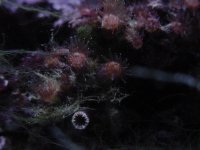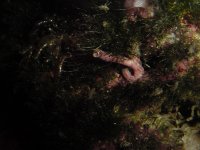I have had what I think is Cladocora cf. arbuscula for 3 years and would like to have a more definite id. I am thinking of moving it into my larger aquarium with PC lighting (currently under NOs). It appears to stay open day and night and doesn't seem to mind water currents (fast or slow). It has grown slightly in the 3 years that I had it (came in on some live rock).
The other id I am requesting is of this alga. It is a bright/dark green (pic. was taken at night with a flash) and is hard/spiny to the touch (not feathery like Bryopsis). I have eradicated most of it from my tank (as it was almost covering everything) by keeping the light off for almost 6months. It still covers 1/2 of one piece. Water test came back good each week (Zero across the board, phosphate 0 as well – had me and my LFS baffled). It does provide a good home to amphipods.
Any help with finding out what these are would be great!
Thanks much!
Sarah
The other id I am requesting is of this alga. It is a bright/dark green (pic. was taken at night with a flash) and is hard/spiny to the touch (not feathery like Bryopsis). I have eradicated most of it from my tank (as it was almost covering everything) by keeping the light off for almost 6months. It still covers 1/2 of one piece. Water test came back good each week (Zero across the board, phosphate 0 as well – had me and my LFS baffled). It does provide a good home to amphipods.
Any help with finding out what these are would be great!
Thanks much!
Sarah







